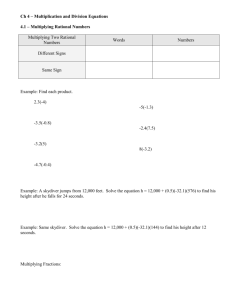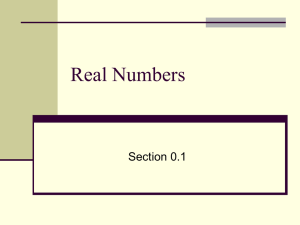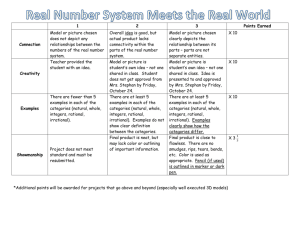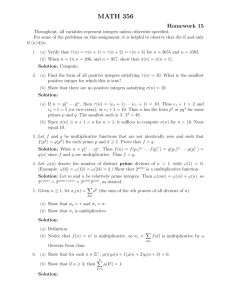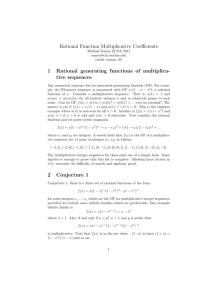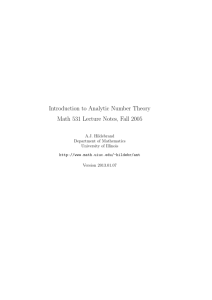Number Systems, Prime Numbers, Groups, and Rings
advertisement
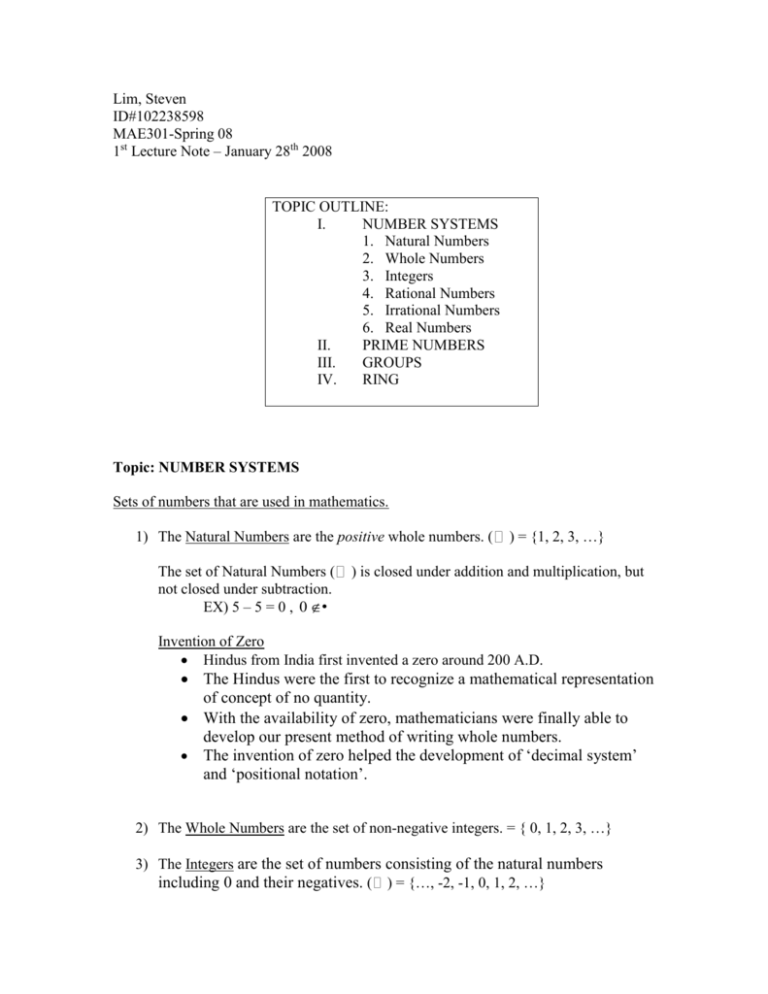
Lim, Steven
ID#102238598
MAE301-Spring 08
1st Lecture Note – January 28th 2008
TOPIC OUTLINE:
I.
NUMBER SYSTEMS
1. Natural Numbers
2. Whole Numbers
3. Integers
4. Rational Numbers
5. Irrational Numbers
6. Real Numbers
II.
PRIME NUMBERS
III.
GROUPS
IV.
RING
Topic: NUMBER SYSTEMS
Sets of numbers that are used in mathematics.
1) The Natural Numbers are the positive whole numbers. (
The set of Natural Numbers (
not closed under subtraction.
EX) 5 – 5 = 0 , 0 •
) = {1, 2, 3, …}
) is closed under addition and multiplication, but
Invention of Zero
Hindus from India first invented a zero around 200 A.D.
The Hindus were the first to recognize a mathematical representation
of concept of no quantity.
With the availability of zero, mathematicians were finally able to
develop our present method of writing whole numbers.
The invention of zero helped the development of ‘decimal system’
and ‘positional notation’.
2) The Whole Numbers are the set of non-negative integers. = { 0, 1, 2, 3, …}
3) The Integers are the set of numbers consisting of the natural numbers
including 0 and their negatives. ( ) = {…, -2, -1, 0, 1, 2, …}
The set of Integers ( ) is closed under addition, subtraction and multiplication,
but not closed under division.
For example, 5/2 = 2.5, and 2.5 is not an integer.
4) The class definition of a Rational Numbers (of a rational fraction) was that it is a
numbers which can be put in the form a where a,d ¢ and d 0 . More
b
complete definition of a rational number is to put additional information, such that
a c when ad = cd.
b
d
5) An Irrational Number is any real number that is not a rational number. In other
words, an irrational number can’t be expressed as p q where p, q ¢ and q 0
The order of sets of different numbers is as follows:
¢ § °
-------------------------------------------------------Topic: PRIME NUMBERS
A Prime Number is a natural number that has exactly two divisors; 1 and itself.
*Please note that ‘1’ is not a prime number, because it is the only number that is not
suitable under definition of prime numbers. How can 1 be divisible by 1 and itself?
Since divisible by 1 is another way of saying divisible by itself for this specific case, 1 is
not included in the definition and therefore it is not a prime number.
-------------------------------------------------------Topic: GROUPS
Definition: A set S is a group if there is a binary operation * such that,
S is closed under *, and satisfying three axioms.
1) There exists an identity element such that for any element, a in the set a S that
a*e=e*a=a
2) For each a S , there exists a unique a 1 such that a * a 1 = a 1 * a = e.
3) The operation is associative. In other words, a,b,c S , a*(b*c)=(a*b)*c
Not all groups are commutative, but if they are, they are called abelian groups.
(Examples of Groups)
is an abelian group under addition, because it meets the following properties of a
group:
1) Closure: let a,b ¢ , then a b ¢
2) Associativity: a,b,c ¢ , then (a b) c a (b c) ¢
3) There exist an identity element zero: a 0 0 a a
4) There exist inverse elements: a (a) 0
5) Commutativity: let a,b ¢ , then a b b a ¢
does not form a group under multiplication because not every elements has a
multiplicative inverses. For example, the multiplicative inverse of 1 is 1 and
multiplicative inverse of –1 is –1. However, multiplicative inverses of any other integers
will be rational numbers, so won’t work.
-------------------------------------------------------Topic: RING
Definition: A set R with 2 binary operations , such that,
(R,+) is an abelian group with identity element 0, so that a,b,c R , the following
axioms holds:
Closure: a b R
Associativity: (a b) c a (b c)
Identity: 0 a a
Commutativity: a b b a
Inverse: a R such that a (a) (a) a 0
(R,
) is a monoid with identity element 1, so that a,b,c R that following holds:
a b R
(a b) c a (b c)
1 a a 1 a
**monoid means binary operation satisfying associativity, identity element and
closure.
Multiplication distributes over addition
a (b c) (a b) (a c)
(a b) c (a c) (b c)
*Note: For some, a ring need not have a multiplicative identity.
[ REFERENCES ]
1) Online Wikipedia: The Free Encyclopedia,
[http://en.wikipedia.org/wiki/Integer], 10 February 2008
2) Niven, Ivan. Numbers: Rational and Irrational. MAA. 2002
3) Marie Milach’s Notes for MAE 301 on September 5, 2007
4) {http://www.geocities.com/borhoo/History.htm], 26
January 2001
5) Online Wikipedia: The Free Encyclopedia,[
http://en.wikipedia.org/wiki/Group_theory],
February 2008
10
6) Online Wikipedia: The Free Encyclopedia,[
http://en.wikipedia.org/wiki/Ring_%28mathematics%2
9],
10 February 2008






